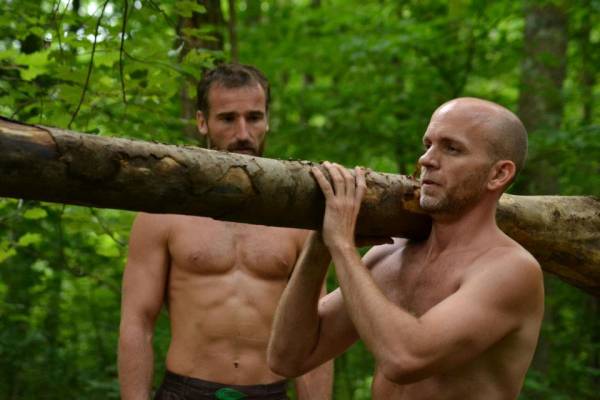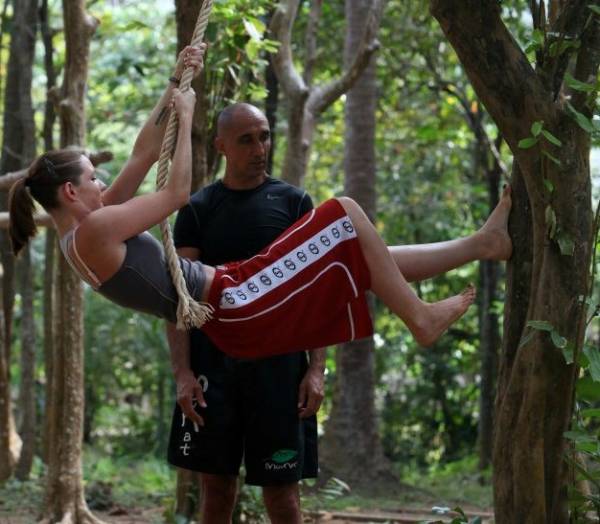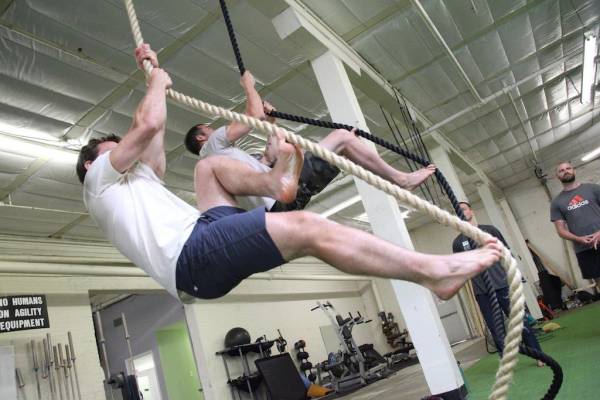To the question, “Where should I train natural movement?” the answer is simple: anywhere and everywhere.
It is essential to be able to move and perform in diverse environments and situations with both effectiveness and efficiency. Indeed, can we even talk about real-life physical competency without including a great degree of contextual adaptability?
Me demonstrating an effective balancing split squat on a 2×4 board, carrying a 90lb child.
Environmental, as well as situational, complexity and variety breed such movement adaptability, along with the motor control and physiological adaptations it entails. So it is tempting to think that to be the most effective and beneficial, or even the purest, training must necessarily be done in the open, in uncontrolled environments, especially natural ones.
But the naturalness of the movement patterns is not dependent on the naturalness of the environment where movement is done. Human natural movement patterns done indoors do not differ from the same patterns done outdoors, except for minute adjustments required for environmental adaptability. But this doesn’t mean that training your movements in a controlled environment versus a natural one is exactly the same. They both present different advantages and opportunities. Both have benefits, as well as downsides.
Uncontrolled (Natural) Environments
Uncontrolled environments are found in nature most of the time, but also in urban settings or even indoors. Uncontrolled simply means the environment has not been designed, built, organised, or modified for the specific purpose of a particular training or method.
“Human natural movement patterns done indoors do not differ from the same patterns done outdoors, except for minute adjustments required for environmental adaptability.”
You cannot shrink a rock to make it smaller and lighter or push the walls to reduce the distance between them. You may find one surface that fits the practice of a given technique or a given level of difficulty, but not others. You may find plenty of varied rocks for manipulative skills, but may need to walk several miles to find a surface for balancing. Uncontrolled environments always present us with a “take it or leave it” or “do it or don’t” proposition.
Advantages:
- Variety or Environmental Complexity: Natural environments may provide amazing variety in term of height, distance, weight, and angles. Not to mention in term of surfaces – rough, smooth, uneven, angled, bumpy, holey, slippery, rugged, cold, hot – which are essential to high levels of adaptability. The variety of surfaces is the aspect most difficult to recreate indoors.
- Environmental Specificity: Not all natural environments provide variety, but this can be used advantageously by forcing you to train and adapt to particular environmental variables and become proficient with them.
- Lack of Predictability: Not always knowing what to expect or how reliable the surfaces are, forces you to be mindful, alert, and responsive. With experience, you will know how to place your foot and bodyweight by just looking at your immediate environment. In that sense, the lack of predictability makes you become better at predicting both the environment and how you should move next. That’s adaptability.
- Lack of Measurement or Quantification: For progressions and progress, you will rely fully on feel and observation, as natural environments make it hard or even impossible to measure anything in term of distance, height, or weight. You will not get mentally focused on numbers, but fully focused on feel, observation, and even instinct.
- Freedom: There are no other rules in nature than the natural laws. As long as you respect the environment and life where you are, you can do anything you want.
- Connection With Nature and Health: Remembering that nature is where we all come from and what we are all made of is a powerful experience that can only take place in nature. There are numerous studies showing that nature makes you more relaxed, more centered, and happier, along with other benefits such as breathing pure air, grounding/earthing, and boosting your immune system.

Working with a trainee at a MovNat certification
Downsides:
- Lack of Variety or Environmental Complexity: Natural environments can sometimes be mono-dimensional – all flat ground, no trees to climb, nothing to balance on, or nothing heavy to lift. Some skills and techniques may not be able to be practiced.
- Lack of Scalability: A lack of variety may also imply a lack of scalability. For instance, there is a vertical surface to climb, but it is too difficult or too easy for your level and therefore not beneficial to progress.
- Lack of Predictability: Surfaces may give, slide under your feet, break as you hang, or move as you land without warning. Even surfaces you believe are reliable sometimes are not. Even weather conditions can change surfaces. For example, the rain makes things more slippery.
- Lack of Progression: This is the direct result of a lack of variety and scalability, as progressions are only insured, or optionally insured, when both these variables are present.
- Lack of Safety: The unpredictability of the environment is a big factor in the increase of risk injury. The lack of scalability can also generate accidents, as you may attempt something too hard due to the lack of a more doable option.
- Lack of Measurement or Quantification: Progressions and progress are confined to feel and observation, as it is hard or even impossible to measure or quantify in term of distance, height, or weight.
- Lower Training Efficiency: When all the downsides mentioned above are combined, it makes for a less effective practice.
With lack of variety and scalability, you may find yourself spending a significant amount of time scouting the area for elements that fit the skills or techniques you would like to practice or the level of difficulty you require. Even when you know where such elements are, they may be far from each other.
“Uncontrolled environments always present us with a ‘take it or leave it’ or ‘do it or don’t’ proposition.”
If time is a concern – say, you only have one hour available for your practice – this is a real problem. You may have to delay entire aspects of your training for another place and time. In addition, the lack of quantification and measurement may hinder your progress, as you are not sure how to compare the difficulty of your practice from one environment to another, from one session to another.
Overall, this is not conducive to efficient and beneficial practice, and leaves you to random, instinctive training and little-to-no programming. While that training option works, it requires a lot of free time.
Controlled Environments
Controlled environments are custom designed for the specific purpose of scalable, progressive, and safe training thanks to predictable and adjustable environmental variables, all in one place.
“Given that controlled environments are custom made, they should provide anything a practitioner or trainer needs to ensure safe, structured, and efficient practice.”
A controlled environment is always artificial in the sense that you wouldn’t randomly find one in nature, but a controlled environment isn’t necessarily indoors. While they are most often indoors facilities filled with equipment and artificial surfaces made of rubber, plastic, metal, and other synthetic compounds, we (the MovNat team) have often arranged controlled environments in nature, entirely made of natural materials, such as logs of varied length, thickness, and weight; flat and round rocks; and wood bars and boards. (Note: in a natural environment, you cannot, of course, control the weather conditions.)
Advantages:
- Predictability
- Safety
- Scalability
- Progressions
- Variety
- Training efficiency
Given that controlled environments are custom made, they should provide anything a practitioner or trainer needs to ensure safe, structured, and efficient practice.
Downsides:
- Lack of Variability in Environmental Complexity: It would be hard to recreate natural, outdoors surfaces such as bark, sand, rock, mud, tall grass, bumps, and holes, as well as weather conditions such as rain, snow, and sun that modify the terrain or how you interact with the terrain while in motion. But the lack of variety is not restricted to the type of surfaces encountered. Sometimes gyms just have minimal equipment. For instance pull up bars where only pull ups can be done, but no actual climbing techniques.
- Lack of Environmental Unpredictability: When you always know what to expect, and that you can 100% rely on the surfaces and equipment you use, it is easy to become less attentive or even completely mindless. Lack of attention in a gym may lead to minor injury, but in nature the consequences can be much worse.
- Too Much Safety: Knowing there is no risk of injury in attempting a difficult move because there’s a crash pad or a perfectly clear and smooth area restricts your performance to mostly a physical feat. With risk of failure, but no actual consequence other than missing and trying again, mental fortitude is hardly trained. This can even give you a false sense of competence that will not apply to outdoors context where danger is actually present.
- Lack of Freedom: Controlled environments are most often confined by walls, not that spacious, and restricted by rules and many “don’ts.” It’s easy to get a feeling of being boxed in since as a matter of fact you are in a box.
- Air Pollution: Indoors spaces are usually filled with rubber, plastic, and chemical contaminants, often poorly ventilated, and deprived of natural materials, surfaces, and energies. Breathing bad air while training high intensity is simply not healthy, and not conducive to high levels of energy.
Conclusion
If you are a solo practitioner of Natural Movement, have plenty of time, and don’t like programs, but instead prefer to follow your intuition and be highly adaptable and free, then uncontrolled environments, natural or urban, are the best and should be your first choice. Training indoors can be fun, but even there you will not necessarily see the value of the scalability and progressions available, and will just use it as a “jungle gym.”
Don’t be mistaken, impressive progress can be accomplished by just practicing intuitively, but if you are a total beginner with little knowledge and experience, there is a lot you will need to learn through trial and error before you can move effectively, efficiently, and safely. From a coaching perspective, uncontrolled environments are challenging, especially if you are teaching a group, and even more so if the group is made of individuals of diverse physical levels, with a greater risk of injury.
“If you are a solo practitioner of Natural Movement, have plenty of time, and don’t like programs, but instead prefer to follow your intuition and be highly adaptable and free, then uncontrolled environments, natural or urban, are the best and should be your first choice.”
Uncontrolled environments are fantastic for practitioners who are experienced enough and want to test their skills, as well as improve their adaptability. Lastly, they are great for anyone who just wants to be outside, breath fresh air, look at beauty, connect with nature, and feel free.
Controlled environments are perfect for beginners who are intimidated by the unknown and need to first acquire basic skills and conditioning, as well as experience and self-confidence. They are also perfect for trainers dealing with clients such as beginners, people greatly out of shape, and specialised athletes, as they have on hand levels of safety, scalability, and progression, as well as means to measure and quantify progress and the effectiveness of their programming.
Last but not least, controlled and uncontrolled environments are complementary, the same way structured and random trainings are complementary. You can choose one or the other, as well as blend both, and get the best of both worlds.


Examples for Creating Your Own Controlled Environment
You can design a controlled environment in your backyard, in your garage, in a corner of the woods, or temporarily at the park with props that you bring. All you need to remember is that it requires predictability, variety, scalability, progressions, and (enough) safety.
Here is a list of props you may use:
- 2×4 wood boards and semi-rounded beams (with a flat side): For balancing, stepping, and jumping and landing variations. Optionally, you can find a way to elevate them off the ground or place them at an inclined or declined angle.
- Flat or uneven rocks (with a flat side), pieces of board, rubber plates: For jumping and stepping up, down, or over. Progressions include smaller landing or stepping surfaces or placing them at a greater distance.
- String or long sticks placed horizontally or diagonally: For jumping, walking, and crawling over, under, or through.
- Small sticks or drawing lines in the dirt or sand: A simple way to create a sense of context and distance, especially for jumping and landing. Distances can be measured with your feet, inch by inch, or even approximately.
- Rocks, logs, rubber plates, medicine balls, sandbags, kettlebells, Olympic bars (and anything heavy, for that matter): For all kinds of practical manipulative skills and techniques. If you are in nature and cannot weigh the rocks you are training with, you can certainly still assess their weight by feel and arrange a selection from light to heavy, small to big.
- Horizontal bar, metal or wood: Permanently or temporarily attach it at whatever height you want, in the woods, in the park, or in the backyard, and use it for jumping, vaulting, balancing, and, of course, climbing.
And don’t forget, a lot of existing surfaces are often available without doing anything. The ledge of a sidewalk for running in balance or landing on the ball of your feet. The bars of swing sets at the park. The paint marks between two parking places for jumping and landing. Open your eyes to opportunistic training and the world is yours!
Further Reading:
- When Comfort Is Uncomfortable: You Need Natural Movement
- Pop Up to the Top Challenge: 4-Week Training Plan
- What Happened to Movement for Health?
- What’s New On Breaking Muscle UK Today
Photos courtesy of MovNat.






